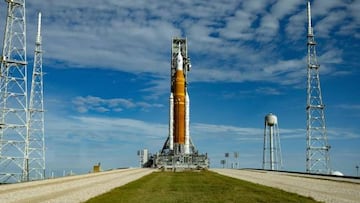NASA’S Artemis 1 Mission: Why is it so important and been delayed several times?
NASA will make another attempt to launch the Artemis I Wednesday16 November, after a series of delays, to return an eventual US manned mission to the Moon.

NASA plans to return humans to the Moon with the Artemis mission since the last lunar landing in 1972 with the Apollo 17 mission. The program consists of stages, but first the US space agency, in conjunction with European Space Agency, Japan Aerospace Exploration Agency, and Canadian Space Agency, must first test the technology.
Artemis I will be an unmanned flight to the moon to verify that the spacecraft and module will keep a human crew safe from the conditions they would encounter. The launch of the first phase has been delayed on four occasions and is five years behind schedule and billions over budget. The latest attempt is set to take place Wednesday 16 November at 1:04 am ET.
Also see:
Should Artemis 1 successfully complete its mission, in the near future astronauts will once again touch down on the lunar surface. It will also begin the process of humans establishing a long-term presence on our neighboring satellite to prepare for an eventual manned mission to Mars. While Artemis I is unmanned, it will give the US space agency an opportunity to test the Space Launch System (SLS), the most powerful rocket in the world, and the Orion spacecraft, the crew module for deep space journeys. The follow-up mission will carry astronauts around the Moon and a third will return humans to the surface perhaps as soon as 2025.
The missions stated purpose for going back to the Moon is “scientific discovery, economic benefits, and inspiration for a new generation of explorers: the Artemis Generation. While maintaining American leadership in exploration, we will build a global alliance and explore deep space for the benefit of all.”
Also see:
Important features of the Artemis I mission
The SLS is the most powerful rocket NASA has ever built, around 15 percent more powerful than the Saturn V rockets that were used to get humans to the Moon. The design has been in the works since 2011 but uses off-the-shelf technology from prior programs that has been thoroughly tested over the years.
The new heavy-lift rocket is made up of the main engines, that are fueled with a mix of liquid hydrogen and oxygen, and two solid booster rockets. The system is capable of generating around 8.8 million pounds of thrust during liftoff
The Orion spacecraft, which will be able to carry astronauts farther into space than they’ve ever gone before, will spend about six weeks in space. Over that time period it will travel approximately 1.3 million miles. It will also go deeper into space than any other spacecraft designed for humans traveling over 270,000 miles away, or 1000 times farther from Earth than the International Space Station.
Key to the mission’s success is the heat shield when the crew module returns to Earth’s. The spacecraft will hit the atmosphere at Mach 32, or 25,000 mph, the fastest capsule reentry since Apollo.
When the #Artemis I flight test launches toward the Moon, it'll mark our first step toward a long-term human presence on the lunar surface.
— NASA (@NASA) September 2, 2022
What do we hope to learn from the uncrewed mission? Here's a look: https://t.co/POsNDV4X2w pic.twitter.com/F4dLqRUSv3
Artemis will take humans to the Moon and beyond
Should Artemis I mission go swimmingly, it will be followed up by Artemis II in a couple years, which will carry a crew to orbit around the Moon. This will allow for more testing of the spacecraft by the astronauts. By 2025, NASA plans to make Artemis III the first manned mission to land on the Moon since Apollo 17 in 1972, however it will most likely be pushed back.
The goal of returning to the Moon is to establish an outpost and a staging ground for manned missions to Mars. The tentative timeline for such a voyage is sometime in the 2030s. Astronauts will be able to learn how to use what is available on-site in preparation for an eventual visit to Mars. “We’re going back to the moon in order to learn to live, to work, to survive,” NASA administrator Bill Nelson explained in a recent press conference.
Next launch window for Artemis 1 mission
After scrubbing the previous four planned launches in August, September and one planned for this Monday, NASA is giving it another go on Wednesday 16 November with the launch window opening at 1:04 am ET with a ninety percent chance that the weather will cooperate.
The delays in getting Artemis I off the launch pad have come down to technical problems and weather. The original launch date 29 August and the following for 3 September were scrubbed when the one of the four engines appeared to be malfunctioning, not cooling down to the right temperature. However, in the end it was a sensor that was giving a wrong reading and the engine was fine.
The following attempt was cancelled when a leak was detected while filling the rockets with the liquid hydrogen fuel. The problem couldn’t be solved in time to launch before the window closed.
The launch windows are set in relation to the rotation of the Earth and position of the Moon. Launching at the optimal moment saves a considerable amount of fuel and happen at specific times, thus why NASA has been waiting since September for another shot.
Despite latest setbacks, the launch will still be broadcast by NASA Television, the NASA app, and the agency’s website, nasa.gov.
Related stories
Coverage will also be available on the agency’s Facebook, Twitch and NASA YouTube channel, as well as in 4k on NASA’s UHD channel.
We will also be hosting a live feed event right here on AS USA, bringing you all the latest information from from the Kennedy Space Center.


